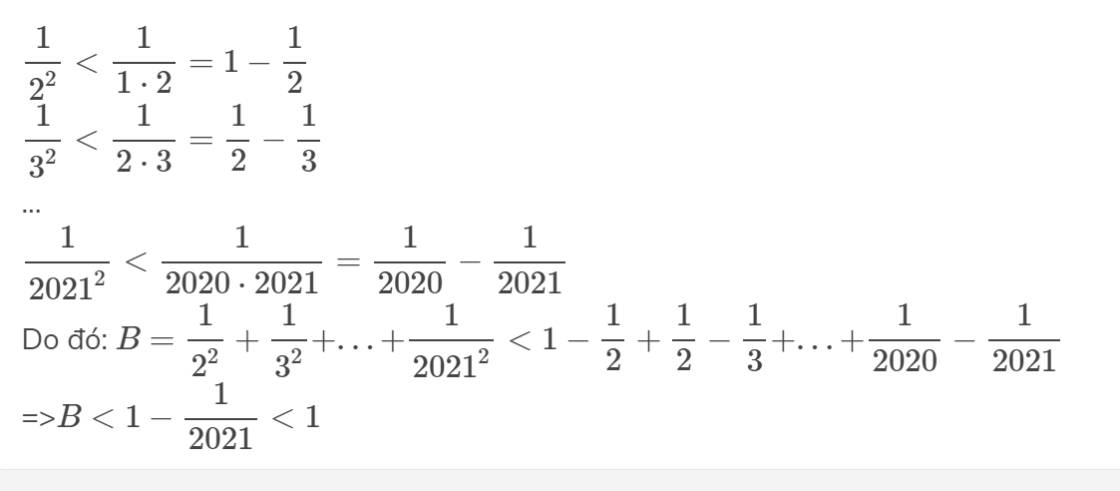

Hãy nhập câu hỏi của bạn vào đây, nếu là tài khoản VIP, bạn sẽ được ưu tiên trả lời.



Bài 4:
a; \(\dfrac{1}{4}\) - \(\dfrac{1}{5}\) = \(\dfrac{5}{20}\) - \(\dfrac{4}{20}\) = \(\dfrac{1}{20}\)
b; \(\dfrac{3}{5}\) - \(\dfrac{-1}{2}\) = \(\dfrac{6}{10}\) + \(\dfrac{5}{10}\) = \(\dfrac{11}{10}\)
c; \(\dfrac{3}{5}\) - \(\dfrac{-1}{3}\) = \(\dfrac{9}{15}\) + \(\dfrac{5}{15}\) = \(\dfrac{14}{15}\)
d; \(\dfrac{-5}{7}\) - \(\dfrac{1}{3}\)= \(\dfrac{-15}{21}\) - \(\dfrac{7}{21}\)= \(\dfrac{-22}{21}\)
Bài 5
a; 1 + \(\dfrac{3}{4}\) = \(\dfrac{4}{4}\) + \(\dfrac{3}{4}\) = \(\dfrac{7}{4}\) b; 1 - \(\dfrac{1}{2}\) = \(\dfrac{2}{2}\) - \(\dfrac{1}{2}\) = \(\dfrac{1}{2}\)
c; \(\dfrac{1}{5}\) - 2 = \(\dfrac{1}{5}\) - \(\dfrac{10}{5}\) = \(\dfrac{-9}{5}\) d; -5 - \(\dfrac{1}{6}\) = \(\dfrac{-30}{6}\) - \(\dfrac{1}{6}\) = \(\dfrac{-31}{6}\)
e; - 3 - \(\dfrac{2}{7}\)= \(\dfrac{-21}{7}\) - \(\dfrac{2}{7}\)= \(\dfrac{-23}{7}\) f; - 3 + \(\dfrac{2}{5}\) = \(\dfrac{-15}{5}\) + \(\dfrac{2}{5}\)= - \(\dfrac{13}{5}\)
g; - 3 - \(\dfrac{2}{3}\) = \(\dfrac{-9}{3}\) - \(\dfrac{2}{3}\) = \(\dfrac{-11}{3}\) h; - 4 - \(\dfrac{-5}{7}\) = \(\dfrac{-28}{7}\)+ \(\dfrac{5}{7}\) = - \(\dfrac{23}{7}\)


Bài 5:
a. Gọi $d=ƯCLN(n-2, n+1)$
$\Rightarrow n-2\vdots d; n+1\vdots d$
$\Rightarrow (n+1)-(n-2)\vdots d$
$\Rightarrow 3\vdots d\Rightarrow d\in \left\{1; 3\right\}$
Để ps tối giản thì $n-2\not\vdots 3$
$\Leftrightarrow n\neq 3k+2$ với $k$ là số tự nhiên bất kỳ.
b.
Gọi $d=ƯCLN(n+5, n-2)$
$\Rightarrow n+5\vdots d; n-2\vdots d$
$\Rightarrow (n+5)-(n-2)\vdots d$
$\Rightarrow 7\vdots d$
$\Rightarrow d\in \left\{1; 7\right\}$
Để ps tối giản thì $n-2\not\vdots 7$
$\Rightarrow n\neq 7k+2$ với $k$ là số tự nhiên bất kỳ.

a; \(\dfrac{x-1}{12}\) = \(\dfrac{5}{3}\)
\(x-1\) = \(\dfrac{5}{3}\) \(\times\) 12
\(x\) - 1 = 20
\(x\) = 20 + 1
\(x\) = 21
b; \(\dfrac{-x}{8}\) = \(\dfrac{-50}{x}\)
-\(x\).\(x\) = -50.8
-\(x^2\) = -400
\(x^2\) = 400
\(\left[{}\begin{matrix}x=-20\\x=20\end{matrix}\right.\)
Vậy \(x\) \(\in\) {-20; 20}
c; \(\dfrac{x}{3}\) = \(\dfrac{14}{x+1}\)
\(x\).(\(x\)+1) = 14.3
\(x^2\) + \(x\) = 42
\(x^2\) + \(x\) - 42 = 0
\(x^2\) - 6\(x\) + 7\(x\) - 42 = 0
\(x\).(\(x\) - 6) + 7.(\(x\) - 6) = 0
(\(x\) - 6).(\(x\) + 7) = 0
\(\left[{}\begin{matrix}x-6=0\\x+7=0\end{matrix}\right.\)
\(\left[{}\begin{matrix}x=6\\x=-7\end{matrix}\right.\)
Vậy \(x\) \(\in\) {-7; 6}
d; \(x-\dfrac{2}{9}\) = \(\dfrac{1}{6}\)
\(x\) = \(\dfrac{1}{6}\) + \(\dfrac{2}{9}\)
\(x\) = \(\dfrac{7}{18}\)
Vậy \(x\) = \(\dfrac{7}{18}\)

Có quá nhiều bài, thứ nhất em đăng tách ra, thứ hai chụp gần cận cho rõ, thứ ba em chỉ đăng bài cần giúp